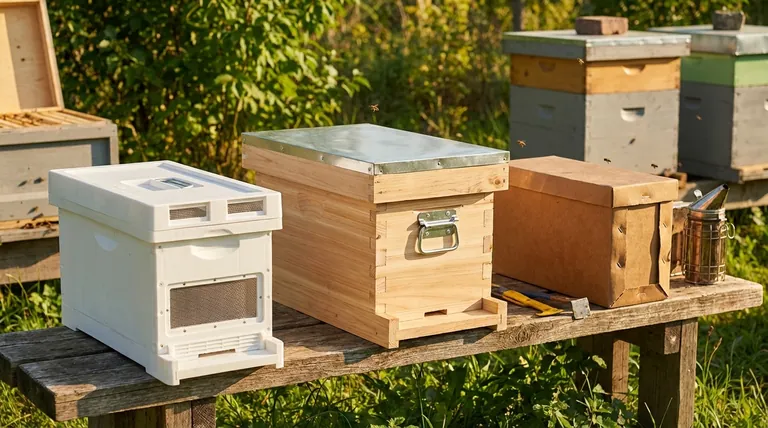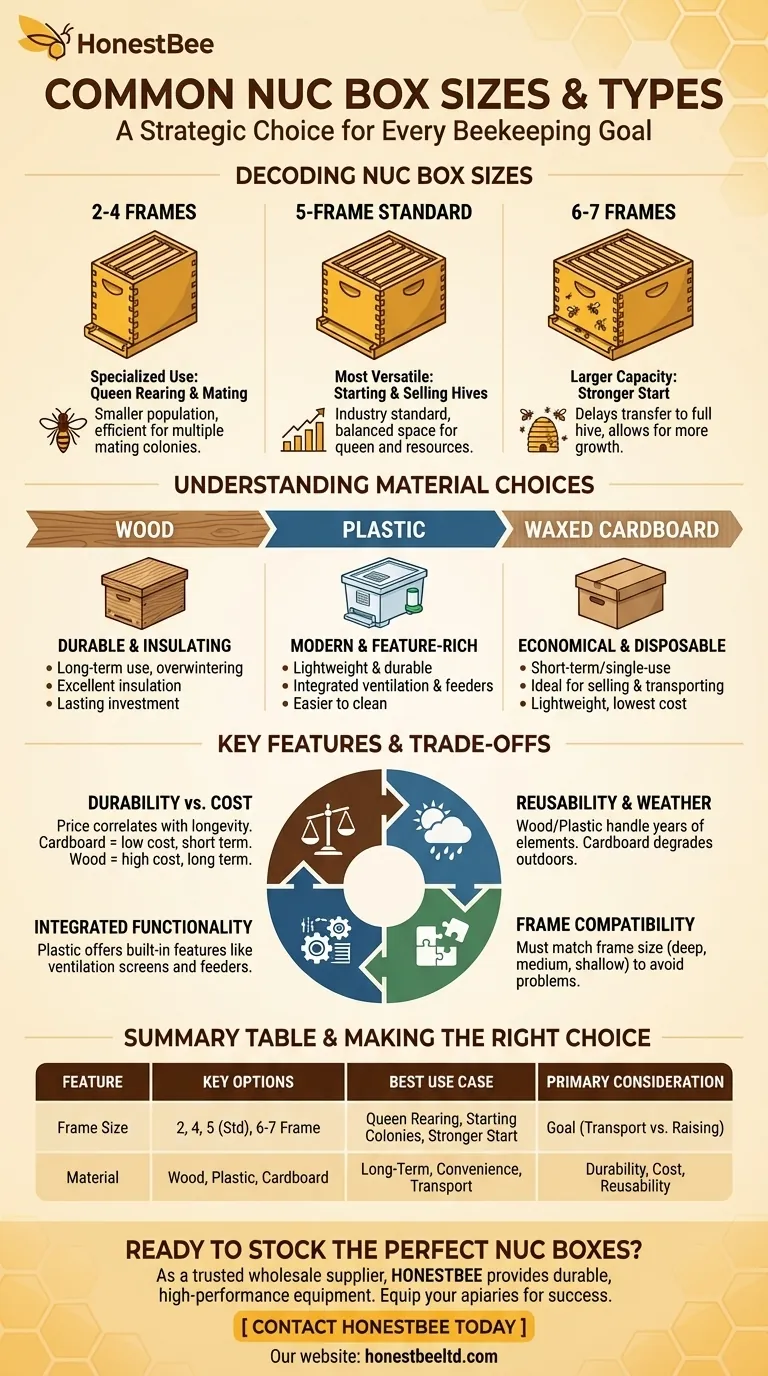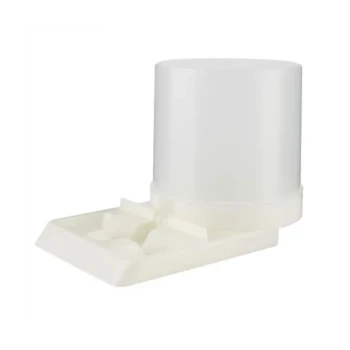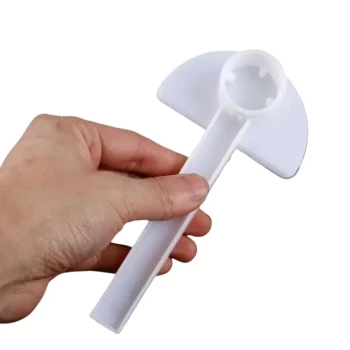The most common nuc box is a 5-frame deep hive, but they are also available in sizes ranging from 2 to 7 frames. These boxes are typically constructed from one of three primary materials: wood, plastic, or waxed cardboard, with each material serving a distinct purpose in beekeeping operations.
The ideal nuc box is not a one-size-fits-all solution. The choice of size and material is a strategic decision directly tied to your specific goal, whether it's transporting bees, raising a new colony, or rearing queens.

Decoding Nuc Box Sizes
The "size" of a nuc box refers to the number of frames it can hold. This capacity directly impacts its best use case.
The 5-Frame Standard
The 5-frame nuc is the industry standard and the most versatile option. When a beekeeper simply refers to a "nuc," they are almost always talking about this size.
It provides a good balance, offering enough space for a queen to lay and for the colony to store resources, making it ideal for starting new hives or selling established colonies.
Smaller Formats (2- and 4-Frame)
Smaller nucs are specialized tools, primarily for queen rearing and mating.
A smaller population requires fewer resources to maintain, allowing the beekeeper to support multiple queen-mating colonies efficiently. A 4-frame box can also be used to start a very small colony split.
Larger Variations (6-Frame and Up)
Larger nuc boxes, such as 6- or 7-frame versions, give a growing colony more room. This can be beneficial for delaying the transfer to a full-sized hive box, giving the colony a stronger start.
Understanding Material Choices
The material of a nuc box dictates its durability, cost, and long-term functionality. Each has clear advantages for different applications.
Wood
Wooden nuc boxes are the traditional choice, prized for their durability and excellent insulation.
They are the best option for long-term use, such as raising nucleus colonies over a season or even overwintering a smaller hive. They represent a lasting investment in your equipment.
Plastic
Plastic nucs are a modern, lightweight, and durable alternative. Many models come with integrated features like ventilation openings and built-in feeders.
They are generally easier to clean and sanitize than wood, offering a practical balance of longevity and convenience.
Waxed Cardboard
Waxed cardboard boxes are the most inexpensive option, designed for short-term or single-use scenarios.
Their primary purpose is for selling and transporting bees. They are lightweight and disposable, making them the standard choice for commercial nuc producers who do not expect the box to be returned.
Key Features and Trade-offs
Choosing a nuc box involves balancing cost, longevity, and special features. Understanding these trade-offs is crucial for making an informed decision.
Durability vs. Cost
There is a direct correlation between price and durability. Waxed cardboard is a low-cost, short-term expense, while wood is a higher-cost, long-term investment. Plastic typically falls in the middle.
Reusability and Weather Resistance
Wood and plastic are highly reusable and can withstand years of exposure to the elements. Waxed cardboard is not designed for long-term outdoor use and will degrade in the weather.
Integrated Functionality
Plastic nucs often lead the way in built-in features. Ventilation screens are critical for preventing overheating during transport, and integrated feeders simplify the process of supporting a new colony.
Frame Compatibility
Regardless of material, ensure the nuc box is designed for your specific frame size, whether that is deep, medium, or shallow. Using incompatible equipment will create significant problems for you and your bees.
Making the Right Choice for Your Goal
Select your nuc box based on its intended function to ensure the best outcome for your bees and your budget.
- If your primary focus is selling or transporting bees: A waxed cardboard nuc is the most economical and practical choice for a one-way trip.
- If your primary focus is raising new colonies or overwintering: A durable wooden or high-quality plastic nuc provides the necessary longevity and protection.
- If your primary focus is queen rearing: A smaller 2- or 4-frame nuc offers the most efficient setup for mating queens.
Ultimately, aligning the nuc box's design with your specific beekeeping objective is the key to success.
Summary Table:
| Nuc Box Feature | Key Options | Best Use Case |
|---|---|---|
| Frame Size | 2-Frame, 4-Frame, 5-Frame (Standard), 6-7 Frame | Queen Rearing, Starting Colonies, Stronger Start |
| Material | Wood, Plastic, Waxed Cardboard | Long-Term Use & Overwintering, Convenience & Features, Selling & Transporting |
| Primary Consideration | Durability, Cost, Reusability | Aligns with your specific beekeeping goal (e.g., transport vs. raising colonies) |
Ready to stock the perfect nuc boxes for your operation?
As a trusted wholesale supplier for commercial apiaries and distributors, HONESTBEE provides durable, high-performance beekeeping equipment. We help you equip your beekeepers with the right tools for success, from standard 5-frame nucs to specialized boxes for queen rearing.
Contact HONESTBEE today to discuss your wholesale needs and get a quote.
Visual Guide

Related Products
- 5 Frame Wooden Nuc Box for Beekeeping
- Plastic Transporting Bee Packages and Nuc Boxes for Beekeeping
- Twin Queen Styrofoam Honey Bee Nucs Mating and Breeding Box
- Automatic Heat Preservation 6 Frame Pro Nuc Box for Honey Bee Queen Mating
- Styrofoam Mini Mating Nuc Box with Frames Feeder Styrofoam Bee Hives 3 Frame Nuc Box
People Also Ask
- How many frames does a typical wooden nuc box hold? A Guide to Choosing the Right Size
- How should the nuc be installed in the apiary? Ensure Colony Success from Day One
- What is a common feature of many 5-frame nuc boxes? The Integrated Feeder for Efficient Colony Growth
- What are the benefits of moving nuclei around the apiary? Master Strategic Hive Management
- What are the benefits of starting a new bee colony in a nuc box? Boost Colony Success with Efficient Beekeeping



















